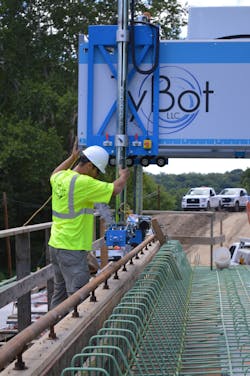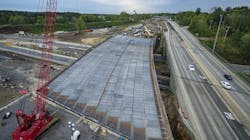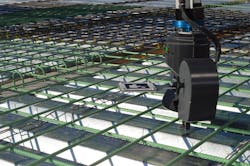The future is here
Historically, the construction industry is rated among the lowest of all major industries in terms of investment in new technologies.
According to McKinsey Global Institute, a business and economics division that analyzes the global economy, construction is the least digitized business segment in the U.S., ranking second-to-last globally. McKinsey further reports that while other industries, such as agriculture, retail and manufacturing, have grown in productivity 1,500% since 1945, the construction industry has remained stagnant and seen little increase.
Today, artificial intelligence, robotics, software advancements and drones are part of the vital transformation the construction industry needs. With the adoption of advanced technologies like autonomous robots, the construction industry could bring about changes resulting in significant increases in productivity, overall cost savings and decreased work-related injuries, all while becoming more attractive to the younger generation’s workforce.
Artificial intelligence (AI) is evident today in the transformation of long-standing business structures changing to meet future needs. Companies are working to prepare the market for a significant adjustment. Ford Motors, now Ford Mobility, is evolving the perception of driving into being mobile and is one of the major players on the forefront of what most call the “fourth industrial revolution.” Ford is one of many competitors to win the race to self-driving cars. This transformation is not simply about technology but also in the mindset and perceptions of the consumer. AI is heavily seen in the healthcare industry and automobile industry, and it is being utilized more and more every day.
The robot had its first deployment on the Pennsylvania DOT’s Freedom Road project in Beavere County, which included a bridge replacement.
Inspiring innovation
Many of the individuals occupying positions in the construction industry currently are part of the large Baby Boomer population and are approaching retirement age. Normally one would expect that these positions would be filled by newer, younger workers. This simply is not happening at a rate that solves the current labor shortage present in the industry and is a topic that ranks high on stressors for many in construction management.
While the Millennial generation is reportedly larger than the Baby Boomer generation, the construction industry is troubled by misconceptions that the industry does not pay high compensation rates and that the jobs are unsophisticated. Tech-savvy young adults are tuned into the delay or lack of innovation, further tarnishing the industry and hindering the labor pool. More and more young adults are seeking bachelor’s degrees and white-collar employment.
A study by the National Association of Home Builders surveyed a group of 2,000 18-25 year olds. They were asked their likelihood of selecting a career somewhere within the construction industry. The result was below 5%. This same study also supported a perspective that construction work is too physically demanding and difficult, again taking the industry off their radar for career selection.
According to the Bureau of Labor Statistics, as of February 2017 close to 200,000 construction jobs were left unfilled across the U.S.
Demand for infrastructure
Safe and competent infrastructure is taken for granted pretty much every day. Nationwide, bridge construction is a large, expanding and renewable market, driven by endemic infrastructure decay, steadily increasing miles driven, population growth and relocation trends. As of 2016, 66.7% of roadways have been deemed to be in “less than good” condition by the U.S. DOT, and according to the Federal Highway Administration’s National Bridge Inventory, 9.1% or 55,710 bridges are classified as “structurally deficient” and 23.3% or 142,614 bridges are in need of repair or improvement.
Coupled with pent-up demand for bridge construction and replacement, the market faces increasing labor scarcity, low productivity, and underutilization of technology. The Bureau of Labor Statistics (BLS) projects U.S. construction labor demand to outpace labor supply over the next five years, with the total number of unfilled construction jobs growing from 200,000 (reported in 2017) to 856,000 in 2021. According to the BLS, compared to 1993 employment levels, the U.S. construction industry should have 1 million more workers aged 19-34 and 1.3 million fewer workers aged 45 and over.
This imbalance is a very real and present-day situation. The construction industry must find ways to innovate infrastructure to keep up with the growth and expansion of the population.
R.S. Audley leased the robot for use on the Rte. 102 Bridge replacement project over the I-93 corridor in Londonberry, N.H.
Adding efficiency and capacity
Pittsburgh-based Advanced Construction Robotics’ (ACR) mission is to create innovative solutions that get people excited about the construction industry while increasing efficiency and productivity.
In 2016, Stephen Muck, CEO of Brayman Construction Corp., and Jeremy Searock, formerly of Carnegie Mellon University’s National Robotics Engineering Center, joined together to form ACR. Their vision was to employ robotics and AI to pioneer and commercialize a wide range of autonomous products to lead this transformation towards enhanced productivity, improved safety, increased profits, and reduced schedule risk.
ACR’s first commercialized, autonomous robot is TyBot, a self-driving, rebar-tying robot that can augment and reduce labor need in the most critical path activity of bridge deck construction. After rebar is laid, concrete cannot be poured until every intersection of rebar mat is tied together. TyBot is capable of tying these intersections continuously day or night without breaks or injuries. The crew carries and places the rebar on one shift while the robot ties on the next shift. In the same way a worker sees rebar intersections, bends over, and ties them with wire, the robot sees the same intersections with its camera and AI and uses precisely controlled motors to move and tie intersections. No prior information is required to be inputted into the robot.
The tying of rebar is a great example of the physically demanding construction work that lacks appeal for the younger generation. It is increasingly difficult to staff and is usually performed during the peak construction season when labor is scarce. Often projects are bid with no clear plan on where the labor will come from, which can cause significant delays in the project’s timeline and jeopardize the project’s profitability.
Rebar tying is a tedious, laborious, repetitive, unpopular and accident-prone activity. The International Journal of Occupational Safety and Ergonomics published a study analyzing manual rebar tying’s effect on worker health to aid in the reduction of work-related musculoskeletal disorders (MSD). This study isolated the manual rebar tie process movement of the wrist, often leading to carpel tunnel syndrome, tendonitis, and shoulder bursitis along with the repetitive bending at the waist leading to back disc rupture. Of the 1,000 construction ironworkers studied, they reported 88% had experienced an MSD during their career.
The robot is being touted for its ability to handle the repetitive and more dangerous work in rebar tying, as well as providing construction crews extra help in the marketplace.
Robots at work
The 60-year-old Rte. 102 Bridge over the I-93 corridor in Londonderry, N.H., is being replaced by R.S. Audley as part of a large-scale 20-mile widening program with the New Hampshire Department of Transportation (NHDOT). It is an excellent example of the magnitude of infrastructure revitalization that needs to happen in the U.S. The bridge spans 370 ft in length and is 120 ft wide. To augment its labor force, R.S. Audley leased TyBot for use on the project.
Adding the robot to the project freed up an estimated four human laborers per shift. These workers remained on-site to focus on other more complex portions of the job.
Working in conjunction with the robot, the crew placed, framed and tied 10% of the rebar in preparation for the robot to take over. Traveling on the already existing screed rails, the robot was on-site, tying rebar intersections for two shifts for five days. It tied 18,391 lb and 3,618 sq ft of rebar per shift, resulting in 728 ties per hour. Ultimately it tied 44,400 sq ft of bridge deck rebar. Scott Stevens, P.E., vice president of R.S. Audley, remarked, “It’s nice because [the robot] operated day and night, rain or shine without breaks. It kept on working, which is exactly what we needed. It is pretty impressive and has been self-sufficient and painless for us.”
According to ACR’s Steven Muck, the robot is a tool fashioned out of the next industrial revolution. “We think the industry is ready to accept the help advanced technology can provide,” Muck said. “[The robot] works alongside existing construction crews, providing extra help in a labor market that needs more workers. We see a future where the robots will do the backbreaking, repetitive and less safe work, while creating new types of jobs for existing workers, such as supervising, servicing and maintaining these robots. These integrated crews will improve the productivity of the entire industry, allowing the rising demand to be met.”
In October 2017, the robot had its first deployment on the Pennsylvania DOT Freedom Road project in Beaver County, Pa. The scope of the entire job consisted of the relocation of S.R. 2004, replacement of an existing bridge over Snake Run Stream, as well as replacement of structures on Romigh Road (T-738 over Crows Run) and Park Quarry Road (T-606 over Crows Run). Brayman Construction was subcontracted to perform the construction of the three single-span integral abutment bridges. In 2017, Brayman completed two of the three bridges: Romigh Road Bridge, which is a two-lane, 80-ft-long span, and Snake Run Bridge, a three-lane, 123-ft span.
Brayman has experienced firsthand the delays and effects of the current state of the industry. “The process of finding workers has become more and more difficult in the last 10 years,” said Muck. “I’ve come to a very firm understanding that we [in the construction industry] are going to have to do things differently, and we’re going to have to supplement what we’re doing with humans with as much technology as we possibly can. The heavy civil industry desperately needs to innovate to improve the productivity in a market where our labor force is shrinking.”
The use of the robot by Brayman Construction (TyBot LLC’s integration partner) on the Freedom Road project was integral to validate the design and the value it provides. Jeremy Searock noted, “We were able to tie the bridge deck quickly using an autonomous robot. This first deployment was a great success and accomplishment for our team. Despite this success, we knew there was room for improvement. We used that experience to make enhancements for today’s product available to the heavy civil construction industry.”
Although it was the robot’s first deployment with conservative goals, it still resulted in a 35% savings to Brayman with respect to man-hours that would have been expended tying the deck rebar in a traditional manner. Since this initial real-life assessment, the speed of the robot has increased and other improvements have been made to support the nationwide deployment in 2018 which was utilized on the Rte. 102 Bridge in New Hampshire. Given its new upgrades, a medium-sized bridge with approximately 53,000 sq ft of bridge deck would see about a 40% reduction in required rebar man-hours and, more importantly, a reduction of about 30 calendar days for the entire project. Reduced, total project days can lead to significant savings from bonus capture, liquidated damage reduction, eliminated site overhead and equipment rentals.
Proving its value, the robot returned to the third and final phase of the Freedom Road project in July 2018. The Park Quarry Bridge is a two-lane, 93-ft long, single-span integral abutment bridge. The robot tied over 6,500 intersections in two four-hour shifts. While Park Quarry is on the smaller side for bridge work, the addition of the robot still resulted in greater productivity overall, further supporting the benefits to innovate.



